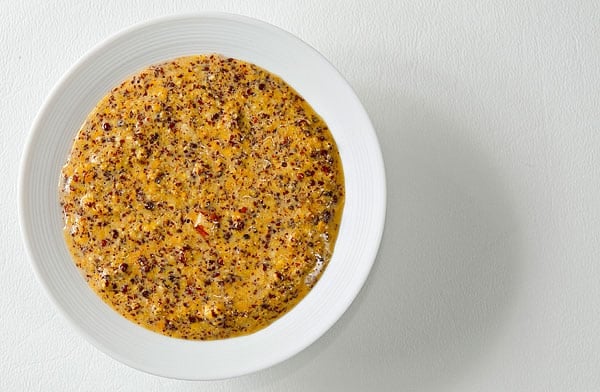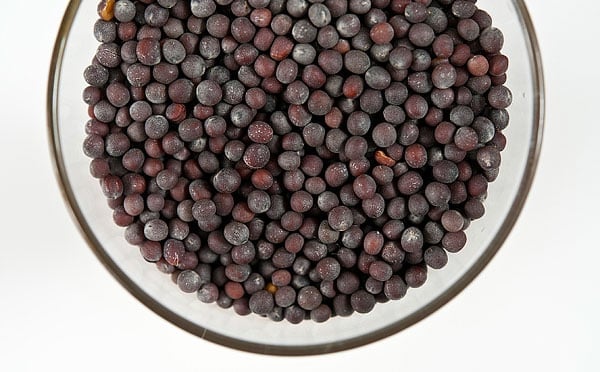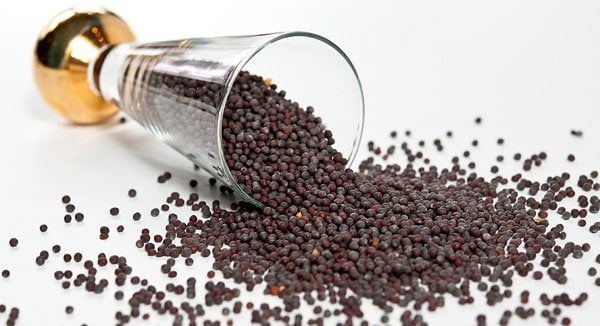As an Amazon Associate I earn from qualifying purchases.

What do you mean you can make mustard at home? It was all I could do to say, “Uh… how did you think it was made? By mustard elves under a tree?” Thankfully, I am older and nicer than I once was. Instead, I said, “Why yes, and it is really, really easy to make.”
I had this conversation with another food blogger, and I tell you this because even for even a food person to not know how to make mustard tells me that it must appear to be magic to most people. But I gotta tell ya folks, it ain’t. If you have mustard seed and water, you can make mustard. It’s that easy. And pretty much every culture in the Northern Hemisphere has done so: Mustard is to the North what chiles are to the tropics.
Mustard is a condiment of a thousand faces. Some are smooth, others almost entirely made from barely cracked seeds. Vinegar is often used, but wine, beer, grape must, and even fruit juices are used to moisten the seeds. Sweetness is usually achieved by adding honey; an American “honey mustard” can be a 1:1 ratio of mustard to honey. A Bavarian sweet mustard, however, uses only sugar and water: no acid, no honey. Italians put fruit preserves in their mustard, a practice I wholeheartedly endorse.
Mustard is one of Europe’s few native spices, although mustard also has been used in Chinese cooking for around 2,500 years as well. Ancient Rome was quite the hotbed of mustard-making, and it is Rome that gives us our name for mustard: It is a contraction of mustum ardens, or “hot must;” the Romans often added crushed mustard seeds to unfermented crushed grapes. I’ve recreated a different Roman recipe for mustard that uses almonds, pine nuts, mustard seed and red wine vinegar. The ferocious bite of this mustard — it should be made with black mustard seeds, the hottest variety — is mellowed by the richness of the nuts. It’s a great accompaniment to roasted meats.
The basic idea behind making mustard is this: Grind seeds and add cool liquid. At its most basic, this is all mustard is. Both Chinese and English mustard (think Coleman’s) is nothing more than water and mustard powder. But there are some things you need to know to make great mustard.
First, you need cold liquid. What gives mustard its bite is a chemical inside the seeds reacting with cool or cold liquid. You also need to break the seeds to get at the fiery chemical — it’s like cutting an onion. Heat damages this reaction, however, so to make a hot mustard use cold water, and warm water for a more mellow mustard. Mustard sauces lose punch when long-cooked, and should always have a little extra fresh mustard tossed in at the end of cooking.
This reaction is volatile, too. Left alone, your mustard will lose its bite in a few days, or in some cases even hours. But adding an acid, most often vinegar, stops and sets the reaction in place — this is precisely what happens with horseradish as well. Adding salt not only improves the flavor, but also helps preserve the mustard, too.
Once made, mustard is nearly invulnerable to deterioration. Mustard is one of the more powerful anti-microbial plants we know of, and, considering it is mixed with vinegar and salt, it becomes a heady mix no wee beastie can survive in. It is said that mustard will never go bad, although it can dry out.
You have three choices when it comes to which variety of mustard seed you use: White, brown and black. White mustard undergoes a different, milder reaction than do brown or black mustards, which are far zingier. American yellow mustard is made with white mustard seed and turmeric, brown mustards are in most of your better mustards, and black mustard is used in hot mustards or in Indian cuisine.

Incidentally, the wild mustard all over California is black mustard. You can thank Father Junipero Serra for that one: He used mustard, which grows like a weed, to mark his travels in Alta California 250 years ago.
The famous Grey Poupon mustard — Dijon has been a center of mustard-making for nearly a millennia now — is traditionally made with stone ground brown mustard and verjus, the tart juice of unripe grapes. I prefer this style of mustard, and most of my homemade mustards are grainy like Dijon. I grind my seeds with a spice grinder, but you could get all old school and use a mortar and pestle.
The best mustards, in my opinion, combine brown or black mustard seeds with yellow mustard powder: The two sets of chemical reactions complement each other and made a more complex mustard.
Always add water or a non-acidic liquid first, let the mixture sit for 10 minutes or so, then add the acid (vinegar, verjus, lemon juice, etc).
Add salt to taste, but it’s typically about 1 to 2 teaspoons per cup of prepared mustard.
Finally, let your mustard set in the fridge or in a cool place for at least a day before you serve it. Bitterness is a byproduct of the mustard reaction, but that bitterness fades after a day or so. Pure mustards can be kept at room temperature, but mustards with other ingredients, like the Roman nut mustard I mention above, should be kept in the fridge.
So there you have it. Easy-peasy. Now you really have no reason to ever buy mustard again.

[recipe_name]Basic Country Mustard[/recipe_name]
[summary]What could be easier than making your own mustard? No, really. It is stupid easy. Grind some mustard seeds, mix with mustard powder and some liquid and you’re done. There is no earthly reason to ever buy mustard once you learn this basic recipe. Endless variations exist. Change the liquid and you change the mustard. Grind the mustard seeds a lot or a little and you change the texture — or skip the whole seeds altogether and use just mustard powder.
Which type of mustard seed do you use? Yellow is what we Americans are most used to, but brown is spicier, more mustardy. Black mustard is stronger still, and it grows wild over much of North America; gather the seeds in late summer or early fall.
Want herbs in there? Go for it. Like honey mustard? Pour some in. Want your mustard even spicier? Add chiles or freshly grated horseradish. I even made a mustard with fresh grape juice from my backyard wine grapes. I called it Deep Purple. Weird-looking, but delicious.
The one caveat to making mustard at home is to wait. You cannot eat it the day you make it. Mustard needs to marinate to dissipate its bitterness. Try it: Eat a little dab right after you make it, then a day or two later. The difference is dramatic.[/summary]
[yield]Makes about 1 cup.[/yield]
Prep Time:[preptime time=12H] 12 hours[/preptime]
- [ingredient][amount]6 tablespoons[/amount] [item]mustard seeds[/item] [/ingredient]
- [ingredient][amount]1/2 cup[/amount] [item]mustard powder[/item] [/ingredient]
- [ingredient][amount]3 tablespoons[/amount] [item]vinegar[/item] (cider, white wine or sherry) [/ingredient]
- [ingredient][amount]1/2 cup[/amount] [item]white wine[/item] or water [/ingredient]
- [ingredient][amount]2 teaspoons[/amount] [item]salt[/item] [/ingredient]
OPTIONAL
- [ingredient][amount]2 tablespoons[/amount] [item]honey[/item] [/ingredient]
- [ingredient][amount]2 tablespoons[/amount] grated [item]fresh horseradish[/item] [/ingredient]
- 1/4 cup minced fresh herbs (really any kind)
[instructions]
- Grind the whole mustard seeds for a few seconds in a spice or coffee grinder, or by hand with a mortar and pestle. You want them mostly whole because you are using mustard powder, too.
- Pour the semi-ground seeds into a bowl and add the salt and mustard powder. If using, add one of the optional ingredients, too.
- Pour in the vinegar and wine or water, then stir well. When everything is incorporated, pour into a glass jar and store in the fridge. Wait at least 12 hours before using. Mustard made this way will last a year in the fridge.
[/instructions]




Somehow I’ve never thought about making my own mustard. Oh well! My shopping list is getting thinner my the day.
Thanks!
Love this post! Thanks, Hank!
This post is wonderful! I’ve made mustard myself before, but I didn’t realize all the details of warm vs. cold liquid, etc. I’m putting mustard seeds on my shopping list for the weekend!
I make my own mustard also, but yours looks quite a bit better than mine…
Thanks for the recipe!
Timely as always! I had just bought about a pound of different mustards from Penzeys in the hopes of making my own. Thanks hon!
Great post thanks…
As a chef i love to cook using mustard and i find using brown mustard is a little less harsh/sharp so i use brown/black seeds and season with that. Haven’t had many complaints 🙂
Huh. Brown mustard seeds always seem a bit mellower to me than the yellow seeds. Yellow has such a raw flavor. Great timing, by the way, I’m needing to make some mustard for christmas presents.
Hank: Great post! And timely. I just cleaned out my spice cabinet yesterday and came upon a little tupperware where I had placed a big bag of mustard seeds. Totally forgot I had them. I just bought a new bottle this week for a little Indian cooking. Isn’t that the way? So now maybe I’ll make my own mustard!
I’m still getting up the guts to make my own pancetta.
Jessa: Keep your mustard in the fridge. It will stay potent for a year or so.
Angelina: Go ahead and use the old seeds. They should be fine. And the vendors are being stupid. I specifically put the different seeds up on my Amazon link because of that. Believe me, there is a BIG difference in flavor between brown mustard seed and black mustard seed.
Okay, I’ve been checking a bunch of online sources for mustard seed and nearly all of them say that brown mustard seeds are also known as black. When I look up black mustard seeds it says they’re also known as “brown”. The other choice seems to be yellow. None of them even mention white mustard seeds. This is why I find it confusing. Is black and brown mustard being sold all really the same seed? I know that botanically there are three varieties of mustard seed that are used in cooking: Brassica Nigra (black), B. Juncea (brown), and B. hirta/Sinapis alba (white). Why don’t all the vendors list the botanical name so I can actually sort this out?
Deana- that was the exact same experience I had growing my own mustard seed- trying to separate the chaff took forever! I ended up with a few tablespoons of seed which I never ended up using because I didn’t want to waste my hard work. Which is backwards thinking. I still have them, 7 years later. Maybe I should finally use them?
Hank- I’ll check out the Amazon link. When I was in Scotland a couple of years ago I got to see this incredible medieval castle kitchen that had been refitted during the 1800’s. There was this enormous stone mortar and pestle that was tall enough to stand at with a grinding surface as large as a kitchen sink (but much shallower) and I think the Victorian family left it because they couldn’t figure out how to move it. I imagine that’s what they ground their mustard on. I’m kind of wishing I had one of those right now.
Jessica: Let us know how it turns out when you make it!
Rebecca: There are grocery stores in Los Angeles?!
Angelina: Sorry, but I can’t help but think of the Louis Prima song when I see that name… I digress. Gulden’s spicy brown is indeed made with brown mustard seeds. The “color” of the seeds is not terribly accurate — both white and brown mustard have a brown seed coat. The black mustard is what Holly took pictures of in the post.
You do need to special order brown or black mustard seeds; the Amazon link above is one way, or you could go to Penzey’s spices online.
And you definitely need to use a spice grinder, not a food mill, to grind your seeds.
Shawn: Nope, no toasting in this case. Remember heat damages the volatile chemical reaction that gives mustard its flavor. I am sure you can still make mustard with toasted seeds, but it will not be as zingy.
JR: Get one down this weekend! Then make corned venison, then make the mustard to go with it. I guarantee you it will be one of the tastiest meals you’ve ever had — going total DIY will do that…
We grew Osaka Red mustard (for the greens, which are *delicious*) in our yard last winter, and decided to let it go to seed so that we could grow some again this year. One overgrown plant produced almost 2 cups of delicious spicy seed, once we winnowed it all out, and we’ve been making some great mustard dipping sauces with it!
This year we’ve planted 6 plants and I’m looking forward to making quite a bit of prepared mustard out of the seed come next summer.
I’d love to figure out a way to jar-preserve mustard without it getting all mild and boring…other than making sure the jar is air-tight, can you recommend anything other than “just make it fresh, you lazy jerk”?
I had to laugh, I made mustard once from my own mustard plants. Separating the tiny seeds from the chaff was insane. I ended up with one small jar when I was done but it was made with homemade verjus with armagnac and was the best mustard… I just couldn’t face the harvest process again… will try your method though.. thanks for the cold/warm water tip!
I think this needs to be paired with your corned venison recipe. I’m hoping to head out for a D3-5 Zone hail mary this weekend, but I fear yesterday and it’s weather may have been my best shot. Rain in the forecast next week so here’s to inclement weather!
I’m with angelina above. I love the spicy brown mustard.
Typically when using whole spices, it is reccomended to briefly toast them before grinding them, but don’t mention doing this in your article or your recipe. Is there a reason for not toasting the mustard seeds?
I have made my own mustard before but I wasn’t quite satisfied with the results. The mustard I use buckets of is the Gulden’s “spicy brown” which isn’t what I’d call particularly spicy. I like that it has just a little bite but is mostly tangy. I can find a thousand recipes for fancy mustards and traditional English mustards, but I have yet to find a recipe for a basic stoneground mustard like Gulden’s.
The mustard I made myself was more like French’s yellow ballpark mustard (because I overdid the turmeric- it was frighteningly bright!)
I don’t suppose it would be easy to replicate stone ground texture with a food mill anyway. But here’s the real problem I have with figuring out how to get the mustard I want: you mention the three types of seed and while the black mustard is very easy to identify (I’ve even grown it myself but it was a pain in the ass to harvest) I don’t know how to tell the difference between the brown and the white. I’ve never seen a brown mustard seed nor a really white one. What I see are the seeds that look yellowish-tan and are sold everywhere as “mustard seed” without the benefit of specifying white or brown. If you can demystify this for me I just may be able to figure out how to make something like the “spicy brown” mustard I love so much. (I am going to guess they use brown mustard seed as the name implies, but how do I know if the mustard seed I have is brown or white?)
I know. I sound like an effing imbecile.
I totally forgot to gather mustard seeds this year. I was planning on it for months on end, and then summer hit and it’s just too damn hot to go out hiking. By the time I went back it was all gone. *sob*
But I didn’t actually know that there were different types, or that dijon was made from brown. And since there ARE grocery stores in LA, I will make my own this week!
I really appreciate the background info too– how the cold water is necessary and the vinegar ‘sets’ it. Since I’m so prone to deviate from instructions that don’t come with reasoning, you’ve saved me from a few batches of mild mustard ;).
I’ve wanted to make mustard for months now. My favorite condiment by far!